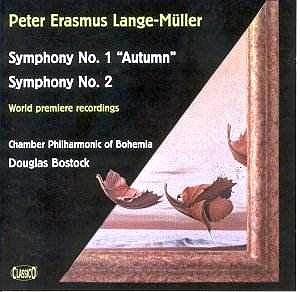Lange-Müller was the child of a cultured and well-connected
Copenhagen couple. Hans Christian Andersen, Oehlenschlager (author of
the Aladdin play to which Nielsen wrote incidental music and
of the words sung by the choir in the finale of the Busoni Piano Concerto),
Niels Gade and Jenny Lind were amongst many famous house guests. Peter
became a prolific composer in this fecundly nurturing hothouse. Despite
his prolific production rate few of his works have any hold beyond Denmark.
The Symphony No. 1 runs for circa 35 minutes
and is in four movements. A briskly musing solo violin ushers in the
symphony in as individual a manner as you could want. This contemporary
of Stanford and Parry writes in a style that has the lift and flight
of Mendelssohn and Dvorak. The vivace is part Rossinian tarantella;
part Hardanger folk dance. The Brahmsian andante sets the scene
for an over-extended finale allegro con fuoco (not fueco
as claimed in the insert sheet).
The Second Symphony was only lightly revised
in 1916. It is substantially the same work as was first performed in
1889. The finale is specially memorable with an ever mobile allegro
festivo which rears up joyously, borne on the wings of Schumann's
Rhenish symphony. Otherwise Grieg haunts the andantes
and the sprightly third movement touches on material from provincial
dance halls - a Polacca. The composer's Dvorakian propensity
and light palate avoids high-flown emotions.
The orchestra is, as the very informative notes confess,
light on the string complement but the resulting balance is confirmed
by Mogens Wenzel Andreasen as authentic to the orchestras of Lange-Müller's
day. This avoidance of lush string tone certainly emphasises the chamber
'lighting' allowing us to appreciate orchestration that, although criticised
by contemporaries, is well put across by players, conductor and engineers.
While the performances do occasionally sound both caring and careful
there is much to enjoy here. However for all the references to late
romanticism these works are much closer to the 19th century pictorialism
of Ludolf Nielsen's orchestral suites, the Borresen symphonies 2 and
3, the Svendsen symphonies, Schumann 2 and 3 and the Mendelssohn Italian
and Scottish symphonies than to the exalted tense Tchaikovskian
romance of Borresen's First Symphony and Violin Concerto, the Macdowell
and Karlowicz tone poems, or of Arthur Farwell, or Vitezslav Novak or
even late Fibich.
Bostock notes parallels with Novak and Fibich. While
I struggle with the Novak links the Fibich references are clear enough
especially in the sparkling writing for wind instruments. Lange-Müller
however lacks Fibich's high tension drama - compare the Sejna Supraphon
mono recording of Fibich's Third Symphony.
I wonder if this present CD is the premiere commercial
recording of the symphonies. Possibly not - no such claim is made in
the booklet. In any event these works are not otherwise commonly available.
In the UK the complete ClassicO catalogue (with many choice items) is
available through DI Music.
There is much to enjoy here and as a listening experience
there are many original and ear-tickling moments. This music is, in
fact, quite a discovery and if you were as disappointed as I was by
the Grieg symphony do not be concerned; the Lange-Müller symphonies
are much fresher in impulse.
Rob Barnett

![]() Chamber Philharmonic
of Bohemia (Pardubice)/Douglas Bostock
Chamber Philharmonic
of Bohemia (Pardubice)/Douglas Bostock ![]() CLASSICO CLASSCD
370 [63.18]
CLASSICO CLASSCD
370 [63.18]